Astrobiology lecture
One of the clearest videos of my astrobiology lecture was recorded when I spoke at the Liverpool John Moores University in November 2013. Here it is on YouTube.
One of the clearest videos of my astrobiology lecture was recorded when I spoke at the Liverpool John Moores University in November 2013. Here it is on YouTube.
My UK Space Agency Aurora Fellowship was to study the effects of the cosmic radiation on Mars on our ability to detect signs of past martian life using Raman spectroscopy aboard the ExoMars rover. The full description of this fellowship proposal is as follows:
Is the Earth the only world in our solar system to harbour life?
This is one of the most fundamental questions asked throughout human history, and one that we are now becoming technologically capable of answering. Astrobiology is the field of science engaged with understanding the limits of life on Earth, and where else the conditions for biology might be met. Mars is believed to have provided the fundamental requirements for the emergence and maintenance of life, at least early in its history. Different lines of evidence, called biosignatures, for extinct, or perhaps even extant, hardy microorganisms may remain detectable in the martian surface. Raman spectroscopy is a promising technique for detecting biosignatures of hidden life and has been selected for the ExoMars-C rover mission, due for launch in 2018.
The martian surface today, however, is hostile to the survival of microorganisms and the preservation of organic biosignatures. A major hazard in the top metres of the martian ground is the penetration of high-energy ionising radiation particles – the cosmic rays. Unlike the Earth, Mars doesn’t receive any significant shielding against this destructive radiation from its thin atmosphere and lack of magnetic field. This irradiation over long timescales will sterilise populations of microbial life and also degrade the complex organic molecules that would remain as biosignatures of their prior existence. ExoMars will also have a drill and so importantly will be able to recover martian soil form a depth of up to 2m underground, where it would have received some protection from the cosmic radiation and harsh surface conditions.
The important questions that need to be answered, therefore, are:
1. How fast do the distinctive peaks of the Raman spectroscopic ‘fingerprint’ of different biosignature compounds decrease with exposure to radiation – i.e. what is the window of opportunity for detecting the biosignatures before they are erased, and so what might be the minimum drilling depth for successful detection?
2. How are the Raman spectroscopic fingerprints of different biosignatures distorted or modified as the compounds break-down under the radiation – i.e., which Raman biosignatures are the most reliable and will remain unambiguously recognisable?I want to answer these questions by using Raman spectroscopy to study pure biosignature compounds and samples of Earthly microorganisms colonising extreme habitats after exposing them to increasing doses of gamma-rays. This will allow me to characterise how the Raman fingerprints of different biosignatures might change, and how quickly they are erased with radiation. I have already used computer models to calculate the radiation environment on the martian surface and at different depths underground. So using my modeling results I can link the total radiation doses used in these new experiments to the length of time that corresponds to in the cosmic radiation on the martian surface and at different depths underground.
By the end of this project, I’ll understand both the manner and the rate of biosignature degradation by ionising radiation, and how deep might be sufficient to expect persisting signs of life with the Raman spectrometer. This understanding will be crucial for the proper interpretation of Raman spectra taken by ExoMars and ensuring the success of this exciting space mission.
Full academic CV as a downloadable pdf
 I read Biological Sciences at The Queen’s College, Oxford (1999 – 2002) and graduated with a First Class degree. My assessed review paper was on bat sonar and moth defences ‘Specialisations for microchiropteran echolocation and moth defence co-evolution‘ and for my independent research project I analysed acoustic recordings using an artificial neural network to investigate ‘Is Humpback Whale Song a Language?‘
I read Biological Sciences at The Queen’s College, Oxford (1999 – 2002) and graduated with a First Class degree. My assessed review paper was on bat sonar and moth defences ‘Specialisations for microchiropteran echolocation and moth defence co-evolution‘ and for my independent research project I analysed acoustic recordings using an artificial neural network to investigate ‘Is Humpback Whale Song a Language?‘
After graduating from my Biology degree at Oxford I moved to University College London for a combined MRes-PhD programme in the deeply interdisciplinary CoMPLEX (Centre for Mathematics & Physics in the Life Sciences and Experimental Biology).
MRes
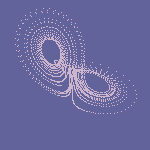
During the first year, the MRes (Master of Research), I was exposed to an enormous amount of physics and instrumentation, as well as mathematical modelling and computational approaches. During this MRes I worked on several small projects, including one on the numerical modelling of chaotic systems – see Runge-Kutta and the Lorenz Attractor – and I published my first paper, on my analysis of the connection architecture of the network of interacting genes that guards our cells against turning cancerous – Robustness of the p53 network and biological hackers (see my bibliography for a downloadable pdf).
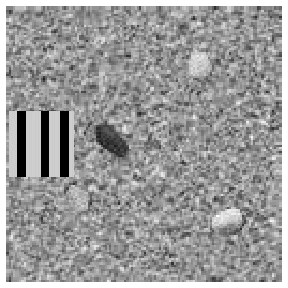
I also worked on a class of optical illusions that disrupt the accurate perception of movement, called motion illusions, that I believed to be linked to a particular display exhibited by cuttlefish. The write-up of this, complete with animations of the motion illusions is available as Motion illusions & active camouflaging.
My major research project for the MRes continued my preliminary work on motion illusions, and a pdf of the final report is available as Illusions disrupting the accurate perception of velocity and position.
PhD
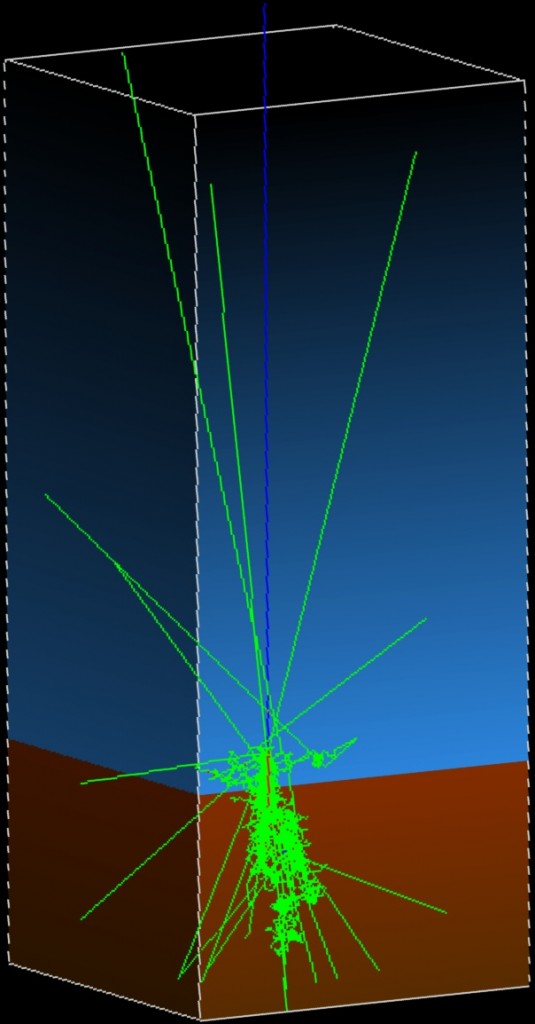 After completing the MRes year, CoMPLEX offers the phenomenal opportunity of being able to chose your own PhD project on the interfaces of biology and approach your own potential supervisors, already fully-funded. I took this chance to move into the field of astrobiology and the search for life beyond Earth. Supervised by Andrew Coates (Mullard Space Sciences Laboratory) and John Ward (Microbiology) I devised an interdisciplinary research project combining computer modelling of the high energy particle physics of cosmic rays and irradiation experiments of extremophile bacteria I isolated from the Dry Valleys in Antarctica, submitting my thesis in 2007. I published a number of papers from this PhD work and my thesis has since been republished by the academic publishers as ‘Martian Death Rays‘. The abstract of my thesis is:
After completing the MRes year, CoMPLEX offers the phenomenal opportunity of being able to chose your own PhD project on the interfaces of biology and approach your own potential supervisors, already fully-funded. I took this chance to move into the field of astrobiology and the search for life beyond Earth. Supervised by Andrew Coates (Mullard Space Sciences Laboratory) and John Ward (Microbiology) I devised an interdisciplinary research project combining computer modelling of the high energy particle physics of cosmic rays and irradiation experiments of extremophile bacteria I isolated from the Dry Valleys in Antarctica, submitting my thesis in 2007. I published a number of papers from this PhD work and my thesis has since been republished by the academic publishers as ‘Martian Death Rays‘. The abstract of my thesis is:
Any microbial life extant in the top meters of the martian subsurface is likely to be held dormant for long periods of time by the current permafrost conditions. In this potential habitable zone, a major environmental hazard is the ionising radiation field generated by the flux of exogenous energetic particles: solar energetic protons and galactic cosmic rays. The research reported here constitutes the first multidisciplinary approach to assessing the astrobiological impact of this radiation on Mars.
A sophisticated computer model has been constructed de novo to characterise this complex subsurface ionising radiation field and explore the influence of variation in crucial parameters such as atmospheric density, surface composition, and primary radiation spectra. Microbiological work has been conducted to isolate novel cold-tolerant bacterial strains from the Dry Valleys environment of Antarctica, an analogue site to the martian surface, and determine their phylogenetic diversity and survival under high-dose gamma-ray exposure frozen at -79◦C, a temperature characteristic of the martian mid-latitude permafrost.
Original results are presented pertinent to microbial survival time, persistence of organic biomarkers, and calibration of the optically stimulated luminescence dating technique, as a function of depth. The model predicts a population of radiation resistant cells to survive in martian per- mafrost soil for 450,000 years at 2 m depth, the proposed drill length of the ExoMars rover. The Antarctic culturing studies identified representatives of four bacterial genera. The novel isolate Brevundimonas sp. MV.7 is found to show 99% 16S sequence similarity to cells discovered in NASA spacecraft assembly clean rooms, with the experimental irradiation determining this strain to suffer 10−6 population inactivation after a radiation dose of 7.5 kGy in martian permafrost conditions. Integrating the modelling and experimental irradiation, this research finds a contaminant population of such cells deposited just beneath the martian surface would survive the ambient cosmic radiation field for 117,000 years.
I am currently a professor at the University of Westminster. I have held a UK Space Agency research fellow at University of Leicester and University of Kent. I was a postgraduate student at University College London, completing my PhD in 2007, and before that an undergraduate at the University of Oxford reading Biological Sciences. Follow these links for more details on my academic work. My CV is available here.
These publications are also available through my entry on ResearchGate.
Academic book chapters:
Academic books / White Papers:
Peer-reviewed journals:
32. Aguzzi, J., Cuadros, J., Dartnell, L., et al. (2024) Marine Science Can Contribute to the Search for Extra-Terrestrial Life. Life, 14(6), 676. Download pdf
31. Averesch, N.J.H., Berliner, A.J., Nangle, S.N., Zezulka, S., Vengerova, G.L., Ho, D., Casale, C.A., Lehner, B.A.E., Snyder, J.E., Clark, K.B., Dartnell, L.R., Criddle, C.S., Arkin, A.P (2023) Microbial biomanufacturing for space-exploration: what to take and when to make. Nature Communications, 14. 2311. Download pdf
30. Mapstone, L.J, Leite M.N., Purton, S., Crawford, I.A., Dartnell, L.R. (2022) Cyanobacteria and microalgae in supporting human habitation on Mars. Biotechnology Advances 59. 107946. Download pdf
29. Aguzzi, J. et al (2022) Developing technological synergies between deep-sea and space research. Elementa 10(1). Download pdf
28. Patel, M.R., Mason, J.P, Nordheim, T.A., Dartnell, L.R. (2021) Constraints on a potential aerial biosphere on Venus: II. Ultraviolet radiation. Icarus. Download pdf
27. Dartnell, L. R. & Kish, K. (2021) Do responses to the COVID-19 pandemic anticipate a long-lasting shift towards peer-to-peer production or degrowth? Sustainable Production and Consumption 27, 2165–2177 . Download pdf
26. Aguzzi, J. et al. (2021) Research Trends and Future Perspectives in Marine Biomimicking Robotics. Sensors 21, 3778. Download pdf
25. Preston, L. J., Barcenilla, R., Dartnell, L. R., Kucukkilic-Stephens, E. & Olsson-Francis, K. (2019) Infrared Spectroscopic Detection of Biosignatures at Lake Tírez, Spain: Implications for Mars. Astrobiology ast.2019.2106 Download pdf
24. Schulze-Makuch, Dirk et al. (2018) Transitory Microbial Habitat in the Hyperarid Atacama Desert. Proceedings of the National Academy of Sciences 115(11) p.2670–2675 Download pdf
23. Domagal-Goldman, S.D., Wright, K.E., Adamala, K., de la Rubia, L.A., Bond, J., Dartnell, L.R., et al. (2016) The Astrobiology Primer v2.0. Astrobiology 16(8) p.561-653. Download pdf
22. Musilova, M., Wright, G., Ward, J.M., Dartnell, L.R. (2015) Isolation of Radiation-Resistant Bacteria from Mars Analog Antarctic Dry Valleys by Preselection, and the Correlation between Radiation and Desiccation Resistance. Astrobiology 15(12) p.1076-1090. Download pdf
21. Dartnell, L.R., Nordheim, T.A., Patel, M., Mason, J.P., Coates, A.J., Jones, G.H. (2015) Constraints on a potential aerial biosphere on Venus: I. Cosmic rays. Icarus 257 (0) p.396-405. Download pdf
20. Nordheim, T.A., Dartnell, L.R., Desorgher, L., Coates, A.J., Jones, G.H. (2015) Ionization of the Venusian atmosphere from solar and galactic cosmic rays. Icarus 245 (0) p. 80-86 Download pdf
19. Herschy, B., Whicher, A., Camprubi, E., Watson, C.. Dartnell, L.R., Ward, J., Evans, J.R.G., Lane, N. (2014) “An Origin-of-Life Reactor to Simulate Alkaline Hydrothermal Vents.” Journal of Molecular Evolution, 79, p.213-227. Download pdf (low-res images)
18. Dartnell, L.R, and Patel, M. (2014) Degradation of microbial fluorescence biosignatures by solar ultraviolet radiation on Mars. International Journal of Astrobiology, 13(2), p. 112-123. Download pdf
17. Preston, L.J., Dartnell, L.R, (2014) Planetary habitability: lessons learned from terrestrial analogues. International Journal of Astrobiology. 13(1), p 81-98. Download pdf
16. Dartnell, L.R, Roberts, T., Moore, G., Ward, J., and Muller, J.-P. (2013) Fluorescence Characterization of Clinically-Important Bacteria. PLoS ONE 8:e75270. Download pdf
15. Zhang, D., Muller, J.-P., Lavender, S., Walton, D., and Dartnell, L.R. (2012) Fluorescent analysis of photosynthetic microbes and Polycyclic Aromatic Hydrocarbons linked to optical remote sensing. In: Int. Arch. Photogramm. Remote Sens. Spatial Inf. Sci., p 555-559. Download pdf
14. Dartnell, L.R., Patel, M., Storrie-Lombardi, M.C., Ward, J.M., and Muller, J.-P. (2012) Experimental determination of photostability and fluorescence-based detection of PAHs on the Martian surface. Meteoritics & Planetary Science 47:806-819. Download pdf
13. Dartnell, L.R., Page, K., Villar, S.J., Wright, G., Munshi, T., Scowen, I., Ward, J., and Edwards, H. (2012) Destruction of Raman biosignatures by ionising radiation and the implications for life-detection on Mars. Analytical and Bioanalytical Chemistry 403:131-144. Download pdf * This publication was selected by the journal editors as a ‘Paper In Forefront’
12. Dartnell, L.R., Storrie-Lombardi, M., Mullineaux, C., Ruban, A., Wright, G., Griffiths, A., Muller, J.-P., and Ward, J. (2011) Degradation of Cyanobacterial Biosignatures by Ionizing Radiation. Astrobiology 11:997-1016. Download pdf
11. Dartnell, L.R. (2011) Ionizing Radiation and Life. Astrobiology 11:551-582. Download pdf
10. Dartnell, L.R., Storrie-Lombardi, M.C., and Ward, J.M. (2010) Complete fluorescent fingerprints of extremophilic and photosynthetic microbes. International Journal of Astrobiology 9:245-257. Download pdf
09. Dartnell, L.R., Hunter, S., Lovell, K., Coates, A., and Ward, J. (2010) Low-Temperature Ionizing Radiation Resistance of Deinococcus radiodurans and Antarctic Dry Valley Bacteria. Astrobiology 10:717-732. Download pdf * This paper was selected as a key article by the journal editor and so offered as Open Access
08. Dartnell, L.R., Fallaize, D., Whiting, S., and Ward, J. (2010) Desiccation resistance of Antarctic Dry Valley bacteria isolated from contrasting locations,. Antarct Sci 22:171-172. Download pdf
07. Dartnell, L.R., and Burchell, M. (2009) Survey on Astrobiology Research and Teaching Activities Within the United Kingdom. Astrobiology 9:717–730. Download pdf
06. Le Postollec, A., Incerti, S., Dobrijevic, M., Desorgher, L., Santin, G., Moretto, P., Vandenabeele-Trambouze, O., Coussot, G., Dartnell, L.R., and Nieminen, P. (2009) Monte-Carlo simulation of the radiation environment encountered by a biochip during a space mission to Mars. Astrobiology 9:311-323. Download pdf
05. Morthekai, P., Jaina, M., Dartnell, L.R., Murray, A., Bøtter-Jensen, L., and Desorgher, L. (2007) Dose-rate variations with depth in the Martian regolith: Model simulations and constraints. Nuclear Instruments and Methods in Physics Research Section A 580:667-670. Download pdf
04. Dartnell, L.R., Desorgher, L., Ward, J.M., and Coates, A.J. (2007) Martian sub-surface ionising radiation: biosignatures and geology. Biogeosciences 4:545-558. Download pdf * This paper was an invited contribition after my EGU Outstanding Young Scientist award
03. Dartnell, L.R., Desorgher, L., Ward, J., and Coates, A. (2007) Modelling the surface and subsurface Martian radiation environment: Implications for Astrobiology. Geophysical Research Letters 34:L02207. Download pdf * This paper was selected by the editors for a ‘Special Highlight’ in the journal
02. Dartnell, L.R., Ward, J.M., and Coates, A.J. (2006) Modelling Planetary Radiation Environments: Astrobiological Perspectives. European Modelling Symposium (ISBN 0-9516509-3-9/978-0-9516509-3-6). Download pdf
01. Dartnell, L.R., Simeonidis, E., Hubank, M., Tsoka, S., Bogle, I., and Papageorgiou, L. (2005) Robustness of the p53 network and biological hackers. FEBS Letters 579:3037-3042. Download pdf
Learned Publications:
08. D. Waltham & L. R. Dartnell (2012), Is the Earth special?, Astronomy & Geophysics, 53(4), p.25–29. Download pdf
07. L. R. Dartnell (2011), Biological constraints on habitability, Astronomy & Geophysics, 52(1), p.25–28. Download pdf
06. L. R. Dartnell (2010), The Search for Our Neighbours, Public Service Review: Science and Technology, issue 7, p.19. Download pdf
05. M. Burchell & L. R Dartnell (2009), Astrobiology in the UK, Astronomy & Geophysics, 50(4), p27–30. Download pdf
04. L. R. Dartnell (2008), A Living Mars?, Geology Today, 24(2), p.62-67. Download pdf
03. L. R. Dartnell (2008), Mars: Waterworld or Dune?, The Biochemist, 30(4), p.22-25 2. Download pdf
02. L. R. Dartnell (2008), Space Bugs, Microbiology Today, May 2008, p.62-64. Download pdf
01. L. R. Dartnell (2005), It’s life, Jim…, Astronomy & Geophysics, 46(1), p1.12-1.13. Download pdf
I am an astrobiology research scientist at the University of Westminster. I explore how microbial life, and signs of its past existence, might survive the bombardment of cosmic radiation on the surface of Mars, and what are the best ways to try and detect it.
After graduating from the University of Oxford in 2002 with a first class degree in Biological Sciences, I moved to University College London for a four year combined MRes-PhD programme at CoMPLEX. I was awarded my doctorate in 2007: my thesis has since been reprinted by academic publishers under the alluring title of Martian Death Rays.
I have also held an STFC Science in Society Fellowship, and often deliver public lectures and live events at schools, and literary and science festivals. I have been invited to speak at prestigious locations including the Royal Albert Hall, the Royal Institution and the Natural History Museum.
Related links: Academic Work // Academic Publications // Curriculum Vitae
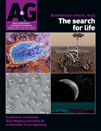 Lewis Dartnell discusses how extremophiles have pushed the survival envelope of terrestrial life – and what this means for the possibility of extraterrestrial life.
Lewis Dartnell discusses how extremophiles have pushed the survival envelope of terrestrial life – and what this means for the possibility of extraterrestrial life.
Download pdf
Also available at Astronomy & Geophysics
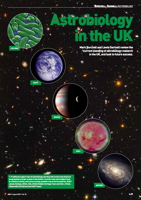 Mark Burchell and Lewis Dartnell review the current standing of astrobiology research in the UK, and look to future success.
Mark Burchell and Lewis Dartnell review the current standing of astrobiology research in the UK, and look to future success.
Download pdf
Also available at Astronomy and Geophysics
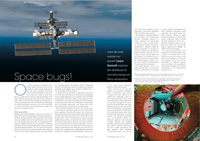 On Earth, microbes get absolutely everywhere. Indeed, there seem to be very few completely sterile natural environments. But what about microbial colonization of locations beyond Earth? In this article we’ll explore the realm of space bugs. There is a great deal of interest in the microbiology of the closed artificial environments created for human exploration of the cosmos, such as the International Space Station (ISS), as well as in minimizing the risks of inadvertently transporting terrestrial contamination elsewhere, and even the possibility of a natural mechanism spraying life between worlds over the history of the solar system.
On Earth, microbes get absolutely everywhere. Indeed, there seem to be very few completely sterile natural environments. But what about microbial colonization of locations beyond Earth? In this article we’ll explore the realm of space bugs. There is a great deal of interest in the microbiology of the closed artificial environments created for human exploration of the cosmos, such as the International Space Station (ISS), as well as in minimizing the risks of inadvertently transporting terrestrial contamination elsewhere, and even the possibility of a natural mechanism spraying life between worlds over the history of the solar system.
Download pdf
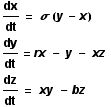 The Lorenz equations are a set of three coupled non-linear ordinary differential equations (ODE). They make up a simplified system describing the two-dimensional flow of a fluid. As can be seen, the derivative of all three variables is given with respect to t, and as a function involving one or both of the other variables (thus they are said to be coupled). The usual values taken by the parameters are as follows:
The Lorenz equations are a set of three coupled non-linear ordinary differential equations (ODE). They make up a simplified system describing the two-dimensional flow of a fluid. As can be seen, the derivative of all three variables is given with respect to t, and as a function involving one or both of the other variables (thus they are said to be coupled). The usual values taken by the parameters are as follows:
sigma = 10, r = 28, and b = 8/3.
As time is incremented then, the calculated values of x, y, z change as shown in the timeseries plot below. x = red, y = green, z = blue.
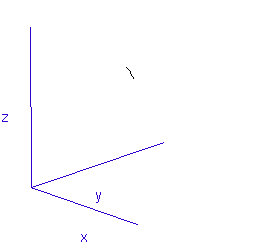 The fluctuations are seemingly utterly random. More structure can be seen, however, if the same timeseries is plotted as a sequence of co-ordinates describing a trajectory through 3-space. As shown to the right, the surface resembles a twisted bow-tie. It is known as the Lorenz strange attractor, and no equilibrium (dynamic or static) is ever reached – it does not form limit cycles or achieve a steady state. Thus, no trajectory ever coincides with any other. Instead, it is an example of deterministic chaos, one of the first realised by mathematicians.
The fluctuations are seemingly utterly random. More structure can be seen, however, if the same timeseries is plotted as a sequence of co-ordinates describing a trajectory through 3-space. As shown to the right, the surface resembles a twisted bow-tie. It is known as the Lorenz strange attractor, and no equilibrium (dynamic or static) is ever reached – it does not form limit cycles or achieve a steady state. Thus, no trajectory ever coincides with any other. Instead, it is an example of deterministic chaos, one of the first realised by mathematicians.
One of the properties of a chaotic system is that it is sensitive to initial conditions. This means that no matter how close two different initial states are (i.e. even down to the 20th decimal place) their trajectories will soon diverge. This is popularly referred to as the “Butterfly Effect”, whereby small changes in the initial state can lead to rapid and dramatic differences in the outcome. The metaphor is that a butterfly flapping its wings in Brazil could result in a tornado in Texas.
The Lorenz equations cannot be solved analytically by integration. Instead, a numerical approximation technique must be used. The 4th order Runge-Kutta (RK) method employed here takes a weighted average of four estimates of the derivative at a point in order to calculate the new position after a time increment. The lower-order error terms cancel out, making RK very robust despite its simplicity.
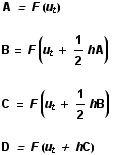 To generate all of these images and animations, a Mathematica programme was written to perform the RK numerical analysis of the Lorenz equations. For the initial state, an arbitrary point in 3-space, ut , is chosen, and then four derivatives calculated (A, B, C and D) using a time increment of h. In each case, F is the three-dimensional vector function composed of the Lorenz differential equations given above. These derivatives are weighted and combined to give the approximation for the next point, ut+h .
To generate all of these images and animations, a Mathematica programme was written to perform the RK numerical analysis of the Lorenz equations. For the initial state, an arbitrary point in 3-space, ut , is chosen, and then four derivatives calculated (A, B, C and D) using a time increment of h. In each case, F is the three-dimensional vector function composed of the Lorenz differential equations given above. These derivatives are weighted and combined to give the approximation for the next point, ut+h .
The three components of this point are appended to a storage list, and then the whole calculation reiterated a large number of times. For the high resolution image above, 100,000 co-ordinates were calculated and plotted, expending almost an hour of computer runtime. For the animation below, only 10,000 points were used.
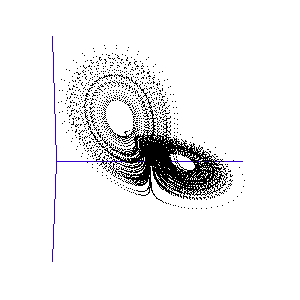 Once calculated, all of the points in this data list are plotted in order to visualise the Lorenz attractor. This draw command was placed in a programme loop, with the x, y, and z co-ordiantes of the viewing-point for the projection incremented each time to generate a string of images. These were then converted into an animated .gif to create the rotating attractor shown to the left.
Once calculated, all of the points in this data list are plotted in order to visualise the Lorenz attractor. This draw command was placed in a programme loop, with the x, y, and z co-ordiantes of the viewing-point for the projection incremented each time to generate a string of images. These were then converted into an animated .gif to create the rotating attractor shown to the left.
The animation of the trajectory through time (shown at the top) was created by calculating just 1,000 co-ordinates, starting with a point known to be near the transition region between the two lobes. Only a subset of these points were plotted each time in the draw loop, beginning with the first 5, then the first 10, first 15, 20, 25, and so on.